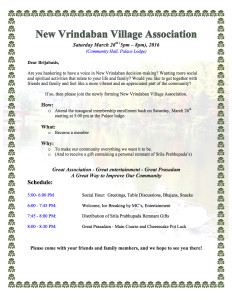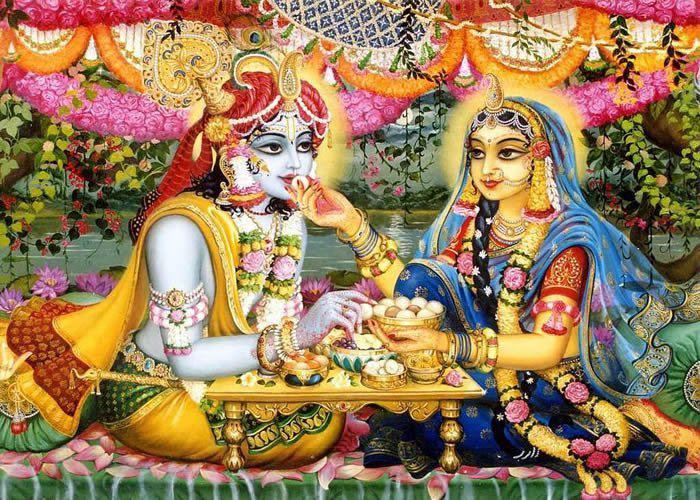
Lecture by HH Bhakti Madhurya Govinda Swami at ISKCON Mayapur ON 2016-03-15
Sridham Mayapur is actually the centre of the universe you can say Kurushetra you can say other places but Sridham Mayapur is the real centre of the universe.
Reading from 7th canto chapter 2 text 16
TEXT 16
evaṁ viprakṛte loke
daityendrānucarair muhuḥ
divaṁ devāḥ parityajya
bhuvi cerur alakṣitāḥ
TRANSLATION
Thus disturbed again and again by the unnatural occurrences caused by the followers of Hiraṇyakaśipu, all the people had to cease the activities of Vedic culture. Not receiving the results of yajña, the demigods also became disturbed. They left their residential quarters in the heavenly planets and, unobserved by the demons, began wandering on the planet earth to see the disasters.
PURPORT
As stated in Bhagavad-gītā, the performance of yajña brings reciprocal good fortune for both the human beings and the demigods. When the performances of yajña were stopped by the disturbances of the demons, the demigods were naturally bereft of the results of yajña and hampered in executing their respective duties. Therefore they came down to the planet earth to see how people had become disturbed and to consider what to do.
LECTURE
This is very amazing because this here Bhagavad is describing what happened it thretha yuga, things were very nice in thretha yuga when comparison to now with kaliyuga. McDonalds, KFC, terrorism, rape and all these things, if you ask people, I do surveys I ask young people how do you like how the society today, fine. Really? So, you are ok with rape crime murder, abortion, terrorism, drought and tsunamis and the list gets longer and longer are you ok with this? Then they stop and think Oh!, umm may be you have a point. It may be its not paradise after all, you know in this kaliyuga. This is the age of darkness, the point is actually what this verse describing today not just thretha Yuga, disturbed again again by natural occurrences cause by the followers of Hiranyakashipu. Alright, so we don’t have a maha Hiranyakashipu fortunately, but we have thousands and thousands of mini Hiranyakashipus on the planet quite capable and empowered by Kali to wreak havoc isn’t it?
We are experiencing so much crooked politicians all over the world not just India. I mean bribery is very easy in India its little more sophisticated in United States, you know, give campaign contributions in United States. Corruption is going on all over the world. Prabhupada was Simha guru on this subject matter, pick on the head, because you know he was a not going spare corruption and deviation from pure dharma. That is where we are today also not receiving the results of the yajña the demigods are also being disturbed. So the demons are cause of disturbance and what’s going on in the planet today actually is a demoniac. A few million Hindus doing Kali puja, Shiva puja Ganesh puja that’s not enough to counteract the disaster of this age. Because this age only the holy name, Yuga dharma can do it. So everyone, (Maharaj makes everyone chant 3 times as follows)
harinama harinama harinama eva kevalam
kalau nastyeva nastyeva nastyeva gatir anyatha
In Vedic culture if you want to emphasis something, you say it 3 times so Mahaprabhu said, “nastyeva nastyeva nastyeva”, there is no other way, no other way, no other way. Other efforts will be half baked or partial or drop in the bucket can’t do very much. Only the Yuga dharma can save this situation. So the demigods are disturbed, but it is this Krishna Consciousness movement introduced by Srila Prabhupada is saving the planet. HariBol!!
Prabhupada has written in, I believe in “Chaitanya Charitamrita” this Krishna Consciousness movement will go down in history for saving the world from our abductors.” Anybody thinks that this world is not in the hands of abductors now please have your head examined. We are already in the hour of darkness, at moment wars breaking out all over the world, so much homelessness. It’s like people think United States is a paradise. There are at least more than 1 million homeless people in United States, in India they can’t imagine such a thing because United States is such a heavily planet, if we take out visa application to go to States, Indian and foreigners to go submit visa application to go to United states. Visa application says, right at the top of visa application says in bold lettering, “We presume that you are going to try to stay,” this is the fact. That is what it visa application says. Once you go to heavenly planet called United States they don’t know how much homelessness is there, people in United Sates that go to sleep without eating and so forth. These things are going on. So actually, I asked Srila Prabhupada personally, Srila Prabhupada, I said, United States is like a heavenly planet you know you, if you go to super market then everything is there. In US you could buy imported jams and jellies real fruits you know & packets good, packet, cereals, canned goods and very fresh produce from various place around the world. It’s like a paradise except the meat department. So I asked Prabhpada, it’s so much like a heavenly planet and so much opulence and all that but no yajña to support it. Of course I was thinking of the BG “yajno vai visnuh”, that you know, “annad bhavanti bhutani”, I was thinking of that sloka I dint spell it out to Srila Prabhupada, I didn’t have to say the verse he knew what l was talking about. There is always prosperity, but there is nothing to sustain it because this prosperity is sustained by yajña and there is no yajña. He said very ominously, it will not last very soon it will be finished.
So, what we see today in the modern world is the dying throes of modern civilisation, like if you kill an animal it shakes for a while before it finally dies, you know rather gruesome that’s where we are so called civilisation. Death rose and things are getting worse and worse, the economy collapses, the Euro was getting almost collapsed they put it together with cello tape. You know why, Do you know why the Goddess of Fortune allows the world economy to keep limping around, do you know why? Because of the sankritan movement, this Krishna Consciousness movement, this book distribution should go on, if we have no vehicles and no money, it will hamper our preaching it won’t go on. We are not so expert to go out barefoot on the street with what’s left of the books so on. And we want to print more and more books, we want to distribute, we want to do peaching.
Television media, see how ISKCON is using the media? So the Goddess of Fortune says these people are too simple I want to collapse the economy, yes, yes I know but just keep it going little longer, because, look see my devotee, see all the wonderful things they are doing like the 50th anniversary in Calcutta, historical event you know and whole of India watch on the television the world taking note of these things. So Krishna keeps it together with cello tape, its Krishna, who restored the Euros and not the bankers. Not a blade of grass moves without the sanction of Supreme Lord, if He wanted it to collapse it will collapse overnight, but no they managed to run here and there do some fancy dancing and pasted back together so the Euro is still going on in spite of so many bankrupt nations.
How do you call this progress, so many nations in Europe, United States are also bankrupt, but it is you know blind faith in people still have faith in US dollars. Wherever I go travelling, they want dollars if they can get it you know it’s a mythology. They worship the dollar. But anyways the point is, it’s going to come to end. What Srila Prbhupada said to me was, very soon it will come to an end. But I was so shaken up his statement I didn’t have the presence of mind to ask Srila Prabhupada what is very soon means. I asked the question 35 years ago, we see the symptoms of the world today of deterioration and collapse. The symptoms are there. Sixteenth chapter of BG makes this very clear just like Hiranyakashipu and his men were doing here, the demons are engaged in horrible unbeneficial works meant to destroy the world they get the sense gratification out of it, then they destroy the world in order to bring that above. So they won’t stop at anything, murder, drug dealing in other words, there was one big big international banker was financing drug smuggling he got caught but didn’t he get punished? No, put to jail? No But if somebody smoked one reefer, then they get 20 year in jail.
There is a story about a veteran you know war veteran he got 10 years of jail for smoking reefer or something. This is Kali Yuga, justice will be determined on how much money you have. You see, this is proven time and again, so this disturbance is going on. This Krishna Conscious movement is the only hope, there is no other hope everything is going down. Now the challenge we face is, clean our own house, because we are chanting Hare Krishna, because we stick our hand in bead bag, sincere devotees change 16 rounds, because we are trying to follow Prabhupada, those that are sincere, yet at the same time Krishna Conscious is not automatic it’s not mechanical. It is what you do in the name of Krishna, it is what you do in the name of Srila Prabhupada, that’s what counts. Not what is on paper? So there is two things Jñāna and Vijñāna. Generally we have more emphasis is on Jñāna than Vijñāna. Vijñāna. is the practical application, we have to execute the practical application of Srila Prabhupada teachings, the teachings of the Shastra, we have to live by it. We have breathe, we have to walk it, they say talk is cheap so talking is not enough, its breathing it, living by it, how we behave with others, how are we treating others as especially other devotees. It does not matter how many years you have been in this movement that is not how you measure advancement of Krishna Consciousness. supposing you have been a devotee for 30 years, Jai. You have got some Nistha, some steadiness but if your heart is hard then it’s a low grade Nishtha right? Yes no? May be nistha of the lowest quality if the heart, Srila Rupa Goswami says, steel framed. We see many 30 years of devotees have still steel framed heart, lacking compassion, lacking mercy lacking, lacking tolerance after practically 30 years of Krishna Consciousness. Lack of humility, puffed up, Doctor Frog, this is going on, Impersonalism,
I don’t know what is like in lady sector but amongst men I find ice-cold impersonalism even amongst senior devotees. You know, I joined the movement in 1967 took imitation in 1968, now I’m a Sanyasi of course these things are external, that’s right. But when I walk around many of my God brothers that I have known for decades, don’t even say Haribol. Don’t even do like this (folding hands) a mini pranam, ice cold where is the advancement? The real advancement in Krishna Consciousness means to become soft hearted. Isn’t it? Yes, no? If you are heard hearted, if you can’t even go like this, (pranam) when you see a Sanyasi the shastra says, you bow down and offer obeisance when you see an Sanyasi ,if you don’t you have to fast. I’m not making it up that’s what the shastra says. But if the sanyasi is going to walk around expecting that everyone is going to fall at neck and pay Dandavat pranams. It is not self-aggrandizement of the sanyasi, it is not the false-ego of the sanyasi, it is the culture it is genuine real civilization.
We have to do a reality check, what do you want to be in thirty years from now in your Krishna Consciousness? Do you want to be hard hearted? you want to be externally successful, you want to claim the corporate ladder and get a pat on the head with big big men is that what u want? Or do you actually want to go to Braj? If if you want to just claim the cooperate ladder you can do that, you can distinguish yourself with your service, you can work v hard , Bhakti Siddhanta Saraswati Thakur said work now, Samadhi Later. That statement from Bhakti Siddhanta Saraswati Thakur of course it’s very important that’s because he didn’t want his men to be lazy sit back and eat lots of prasadam, he didn’t like it when his sanyasis are overweight, No, he didn’t want his men to be lazy, just eat lots of prasadam, do little bhajans and say some sloka, eat some more prasadam take a nap etc. . He didn’t want that. So he said “Work now Samadhi later to prevent laziness” But is that all in all? It is been misinterpreted that famous statement by Bhakti Siddhanta Saraswati Thakur has been misinterpreted. So the result is if you misinterpret that statement by Bhakti Siddhanta Saraswati Thakur then you neglect inner development. Something that Aindra Prabhu constantly said, non-stop, stressed inner development in Krishna Consciousness.
If you don’t develop the inner nature, if you don’t become soft hearted you missed the whole point. We see devotees are sometimes cruel, See a dog kick it, and is that Krishna Consciousness? Is that what you know? Gaura Kishora Das babaji once he was taking Prasad and then there was a female dog moved in somewhere near his hut. So the 5 puppies came to his hut, they were to eat Prasad off his plate. So his servant was freaked out (enacting to shoo the dog), you know. He was freaking out. So Gaura Kishora Das babaji said, “Don’t do that they are dham vasis”, if you do that I will fast. Oh .also should we take example fro materialist, prakratha bhakta?
You can’t be thirty years devotee and still be a materialist if your heart is not soft, if you can pass another senior Vaishnava and you can’t even say Haribol, then your granthi is very strong. Granthi means the knot in the heart is very strong. Impersonalism, in so many ways, our movement was infected by impersonalism not exactly mayavadi philosophy but just coldness in dealings between certain levels of devotees, you know. This must be measured against what Shastra says. We are supposed to follow what the shastra says we are supposed to follow. If you study, I guess all of you to study the instructions of Vaishnava acharyas, Narottam Das Thakur, Srinivas Acharya. Their biographies are available, I have them I have a set of Biographies available in my computer drive, I can give it to you, Biographies of Vaishnava saints and study their dealings , not only our Prabhupada but previous acharyas sat goswamis. What is Vaishnava behaviour? We are supposed to know, we have to know the Vijñān, we have to know the practical applications for these teachings, how to apply this teachings otherwise what will happen is, I was watching at the ILS, ISKCON leadership Sanga, they were showing a film, the devotees going on in the streets and introducing people to Mahamantra for the first time, as a part of the 50th anniversary celebration. So they were getting people just to chant Hare Krishna, Hare Krishna, happy, peace. People were laughing and smiling and ecstatic Hare Krishna, Hare Krishna ecstatic happy, you know they are chanting, they are brand new to Krishna Consciousness but they are chanting and they are very happy. You get it?, they are brand new to Krishna Consciousness. But sometimes, what is it, after 30 years you are not happy. (Enacting how they act)Urr urr, Chant to be happy prabhu, you know is it like that? Is that advancement in Krishna Consciousness? You will get what you want because Krishna Consciousness movement, the Shastra is teaching us.
Srila Prabhupada says the shastra is the desire tree. You will get what you want out of it. If you want to become a big man or big woman you can do that well what’s going on internally? Did we neglect their internal development then we will be going mechanically. I may have big big positon but what is the merit, if I’m hard hearted, I miss the point.
We have to take example from the acharyas read it please if you want to give me your pen drive, I have right here in my computer, life’s of Vaishnava acharyas. What are their sweet loving relationship always placing the topmost values on the other devotees without consideration, you understand? Yes? Without consideration of their position is he a big devotee oh! If he is famous or not famous, the real vaishanvas not make those considerations. Why shall we make those considerations? Those considerations are Prakrta-Bhakta, I don’t care if you have been chanting for 30 years, Prakrita-Bhakta, Kanishta adikari. Actually what we have in our movement is generally mixture between Kanishta and Madhyama. Kanishta can do what’s done in this movement. we have many mixture between kanishta and Madhyama who are preaching and doing all kinds of things. But the mixture between, not 100% madhyama. If they are preaching they must be madhyama, yes, but are they 100% Madhyama? I came across a very shocking statement by Srila Prabhupada, it shake me up. Srila Prabhupada said anyone who is attached to honour is Kanishta Adikari, I said oh my God!! I’ve been always thinking myself as Madhyama adikari, some sort, but not very high madhyama, and I can preach, and I can increase the faith in the hearts of devotees in one hour. I can do many things by mercy by the mercy of Srila Prabhupada, what can I say that I’m free from desire, No? Yes ir no? So then I myself holding up the mirror because in the Bhagavad Gita Krishna says “the introspective sage”, so we have to hold up the mirror and look within ourselves where am I spiritually? Now we live in a world of demons and same things are still going in kaliyuga and getting worse and worse how come we reform the world unless we have compassion, tolerance and love? What will happen to thousands of innocent people we bring them to Krishna Consciousness? Chant and be happy they become ecstatic, they love chanting Hare Krishna, they get into the movement and then find out that some leaders are hard hearted. What is it going to do their faith, to find out some leaders are intolerant? What’s that going to do to their faith? Because everyone in this movement whether they are so called big devotee or whether they are officially Acharya or whether they are just passing out books, in any case, every single devotee must be “mini archarya”, why? Because we are representing Srila Prabhupada and Krishna. People cannot see Krishna, He is God, and He is unapproachable. His toenails cannot even be approached by yogis but Prabhupada is making available so, representing Krishna. All that they know about Krishna, is through devotee. That’s all I know whatever opinion they develop about Krishna is dependent on the quality of presentation made by the first devotee that they talked to. Isn’t it? Everyone has this experience, if you enliven them, inspire them, and get them going in chanting and get them going in reading & Srila Prabhupada books then that is called real preaching. They get favourably experience in Krishna Consciousness they will carry on, want more association like that you know? So our duty is non-stop, always representing Krishna, many acharyas. Never mind position if you sit on vyasasan, you are Acharya, not like that. You know some of you have a special position, that is very good but everyone must be mini Acharya, small Acharya by example. We have to teach Krishna Consciousness by our example. Then there will be ultimate Hare Krishna explosion when we are the movement is exploding, expanding but we want quality as well as quantity, Isn’t it? Yes? So we have to be very careful about institutional racism because you know there’s prathista. Prathista means positon, attachment, and that can that can strength the grumpier knot in the heart, you know, that can cause one to chant with the 10th offense. If you are attached to position, order and power and whatever then that 10th offense certainly is there, then they will be trouble. Then we see many of my God brothers, very very dedicated, but because of the 10th office hati-mata, the mad elephant offense against Vaishnavas they fell down. Some of the my greatest God brothers have most impressive results externally, a millions of books distributed thousands of devotees made, open so many temples built those that fell down why? Was Krishna unappreciative? Should we conclude Krishan didn’t appreciate their hard work and glorious accomplishment? No, hati-mata. Engage in every case, hati-mata, Vaishnava aparadha, puffed up, proud, prathista, it is a killer. So, we have to be careful, we have to think about the sloka in Bhagavad Gita, about introspective sage. We have to hold up the mirror and look inside, we have to give ourselves honest report card just like that. I conclude by reading this one of my favourite verse in Srimad Bhagavatam,
[SB 1.2.17]
srnvatam sva-kathah krsnah
punya-sravana-kirtanah
hrdy antah stho hy abhadrani
vidhunoti suhrt satam
Sir Krishna who is Supreme Personality of Godhead is the paramatma who is in everyone’s heart and is benefactor of the truthful devotee. We may think, well, I don’t tell lies, no but it’s deeper than that. But we don’t have time to discuss. The truthful devotee cleanses the desire for natural material enjoyment from the heart of the devotee who has developed the urge to hear His messages that means a little bit of Ruchi at least, which are themselves virtuous when properly heard and chanted. So we have to truthful we have to hold up our mirror, what is my progress we have to give ourselves our own progress report, you see. Just not waiting until somebody else or a superior corrects us, we ourselves have to do constant self-evaluation then we can progress in the movement. Thank you very much.










 By Giriraj Swami
By Giriraj Swami





 Sponsor a Kalash
Sponsor a Kalash
 Offerings for Mahaprabhu
Offerings for Mahaprabhu 









 By His Divine Grace A.C.B. Swami Prabhupada
By His Divine Grace A.C.B. Swami Prabhupada By Chaitanya dasa
By Chaitanya dasa



















































